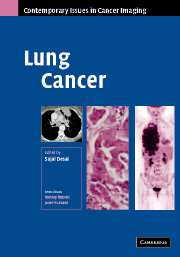Book contents
- Frontmatter
- Contents
- Contributors
- Series Foreword
- Introduction
- 1 Clinical Considerations in Lung Cancer
- 2 Pathology of Lung Cancer
- 3 Imaging of Lung Cancer
- 4 Screening for Lung Cancer
- 5 Staging of Lung Cancer
- 6 Positron Emmision Tomography in Lung Cancer
- 7 Contemporary Issues in the Systemic Treatment of Lung Cancer
- 8 Radiotherapy in Lung Cancer
- 9 Surgery for Lung Cancer
- Index
- Plate Section
- References
9 - Surgery for Lung Cancer
Published online by Cambridge University Press: 12 August 2009
- Frontmatter
- Contents
- Contributors
- Series Foreword
- Introduction
- 1 Clinical Considerations in Lung Cancer
- 2 Pathology of Lung Cancer
- 3 Imaging of Lung Cancer
- 4 Screening for Lung Cancer
- 5 Staging of Lung Cancer
- 6 Positron Emmision Tomography in Lung Cancer
- 7 Contemporary Issues in the Systemic Treatment of Lung Cancer
- 8 Radiotherapy in Lung Cancer
- 9 Surgery for Lung Cancer
- Index
- Plate Section
- References
Summary
Introduction
Surgical resection has, for most of the past century, been considered the main hope for cure in patients with non-small cell lung cancer (NSCLC). However, it is fair to state that this view is changing. Although surgery may be curative, it is salutary to note that operative treatment is a viable option in only around 10% of patients. The reasons for this are relatively straightforward: most patients have advanced stage disease at presentation, and impaired pulmonary function or co-morbidity preclude major surgery. Moreover, the success rate for resection in this select group is generally low and it must be noted that even in stage I disease, 5-year survival is only 65% after surgery.
The limited scope and success of potentially curative surgical resection may be compared historically with the even more modest successes of radiotherapy and chemotherapy. However, there has been something of a recent revolution; significant improvements in outcomes (with chemotherapy in particular), have offered new hope to patients with lung cancer and have helped to clarify and refine the role of surgical resection for primary lung cancer. Indeed, far from reducing the role of surgery, this welcome and long overdue improvement in survival with combined treatment modalities is likely to increase the role of surgery by expanding the accepted clinico-pathological stages likely to benefit from resection.
Radiologist and Surgeon Working Together
An obvious but important tenet of lung cancer surgery is that resection is only effective for localized disease.
- Type
- Chapter
- Information
- Lung Cancer , pp. 136 - 142Publisher: Cambridge University PressPrint publication year: 2006



